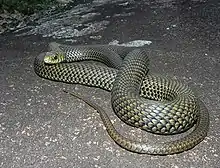Pseudablabes patagoniensis
Pseudablabes patagoniensis is a species of venomous snake found in South America.
| Pseudablabes patagoniensis | |
|---|---|
 | |
| Scientific classification | |
| Kingdom: | Animalia |
| Phylum: | Chordata |
| Class: | Reptilia |
| Order: | Squamata |
| Suborder: | Serpentes |
| Family: | Colubridae |
| Genus: | Pseudablabes |
| Species: | P. patagoniensis |
| Binomial name | |
| Pseudablabes patagoniensis (Girard, 1858) | |
Description and behavior
Pseudablabes patagoniensis is a medium-sized, cylindrical and robust snake, the tail is moderately long and can grow to a maximum of 150 cm, the snout is rounded, with medium-sized eyes with rounded pupils, the dorsal scales are smooth with unique apical scores.[1] P. patagoniensis is terrestrial, fundamentally arboreal when foraging and has daytime habits. It has a brownish color that helps in its camouflage, this species has sexual dysmorphism in adult specimens, females have a longer body, with greater corpulence, while males have a larger tail, females are born with a greater rostro-cloacal length and reach sexual maturity later than male, about 2-years-old, the male can reach sexual maturity at 1-year-old. Reproduction is seasonal, with the vitellogenic season occurring between the months of July and October. They can feed on other snakes and even on the species themselves, juveniles feed on ectothermic animals, while adults feed on endothermic animals. P. patagoniensis can be preyed upon by birds such as Cariama cristata and Tyto alba, as well as other snakes such as Boiruma maculata.[2]
Range and habitat
This species is endemic to South America, it can be found in Argentina, Bolivia, Brazil, Paraguay and Uruguay. Found mainly in places of dry to humid forest.[1]
Common names
Corre campo, parelheira, parelheira comum, papa pinto, culebra del alfa, culebra de los pastos, ratonera and Mboi Hovy.[1]
Venom
This species produces its toxic saliva through the Duvernoy's gland, its toxin is constituted by 90% protein, mainly metalloproteinases, the biological activity of the toxins is very similar to that of Bothrops, with edematogenic, hemorrhagic, nociceptive and necrosis activity of this compound. This species has an LD50 of 58.58 µg / mouse, a value close to Bothrops jararacussu with 58.8 µg / mouse, its toxicity is between Bothrops alternatus with 67.5 µg / mouse and Bothrops jararaca with 24.7 µg / mouse. However, P. patagoniensis has opisthoglyph dentition and has difficulty injecting venom.[2] Its venom also contains neurotoxic and myotoxic components, which result in neuromuscular block and myonecrosis.[3]
References
- "WCH Clinical Toxinology Resources". www.toxinology.com. Retrieved 2020-11-17.
- http://dspace.unipampa.edu.br:8080/jspui/bitstream/riu/511/1/Marcio%20Tavares%20Costa.pdf
- https://biblioteca.univap.br/dados/000002/00000200.pdf
| Wikimedia Commons has media related to Philodryas patagoniensis. |
| Wikispecies has information related to Philodryas patagoniensis. |